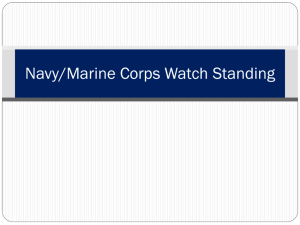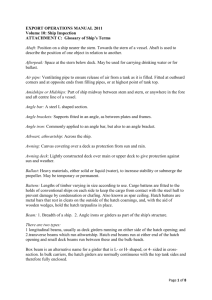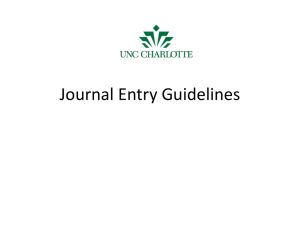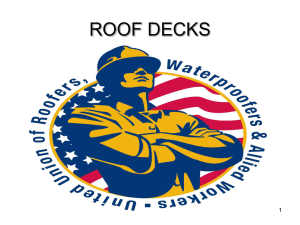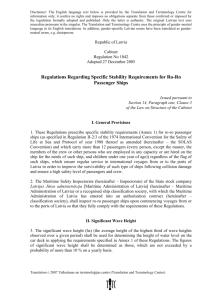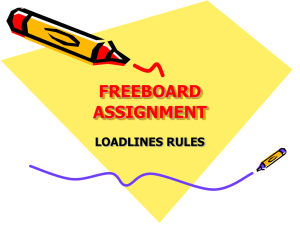Watchstanding 132.1 KB
advertisement
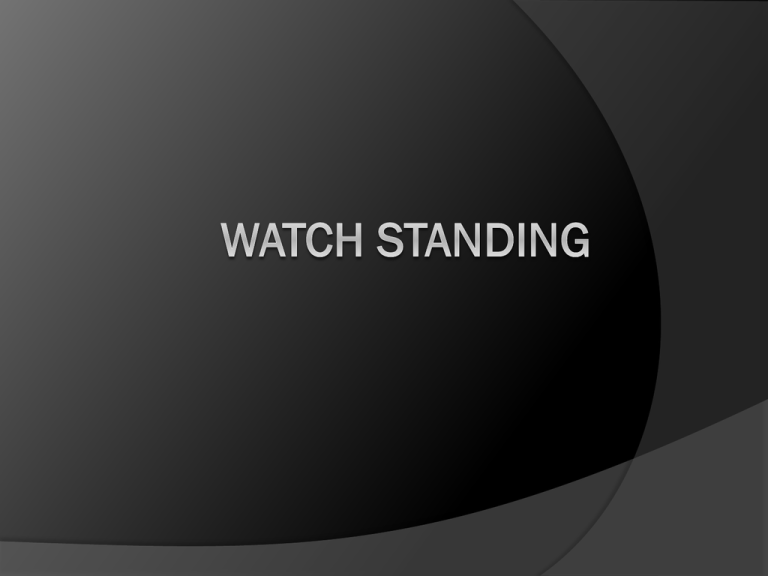
Learning Goals Recognize the responsibilities of personnel for the Watch, Quarter, and Station Bill Identify types of watches, general orders of a sentry, procedures to follow when relieving an armed watch. And when a weapon may be fired. Recognize the duties of lookouts. During a ships entire life there is always sailors on watch. Whatever type of watch the sailor must devote their full attention to their watch. The watches keep the ship running smoothly 24 hours a day. It is always necessary to keep a watch for communications, security, and safety . Watch Done Right Watch done wrong Deck Log The most important log you keep is the deck log The deck log is a complete daily record, by watches, of every event of importance or interest about the crew and the operation and safety of the ship. Deck logs are important for historical and legal reference, it can be used in court, in an incident involving the ship, the log may be the only available evidence to base a legal decision. At sea the log is kept by quartermaster of the watch, in port entries are made by the petty officer of the watch. Deck log entries Entries are handwritten using a black, ball point pen. Entries must be neat and legible, use standard Navy phrasing, because the log may be used as evidence in legal proceedings do not erase entries. If you make a mistake draw a single line through the original entry leaving it legible, insert the correct entry, then place your initials in the margin. The log is signed at the end of each watch by the officer of the deck. Name printed below the signature, date, time, a diagonal line across the remaining page stating no further entries. Entries that are always recorded Convening of court martial or fact finding bodies Inspections held, including administrative, material, personnel, lower deck, and magazine inspections Injuries, accidents, and casualties Official visits Salutes fired and flags displayed Arrivals and departures of the commanding officer, executive officer and, if on board, flag officers and civil officials Drills held Observance of sunrise and sunset Reports made to the Officer of the deck Equipment casualties Departure time and return time of the roving watch Roving watch report, observations etc. Watch, quarter, and station bill For any ship to carry out its assigned missions and tasks, it must have an administrative organization. In the organization, every person is assigned one or more tasks. Personnel are trained so they can do their jobs. It is your responsibility to check the bill daily and refresh your memory as to your duties and stations. Most of the watches in the Navy are 4 hours, watch usually start on the even hours such as 1200 or 0200, however you should arrive at your station at least 15 minutes early to receive any pertinent information or orders from the person you are relieving. Grooming standards and uniform appearance must be followed. Regardless of the watch you stand, observe proper military bearing. Stand your watch in adherence to the eleven general orders of the sentry. Know the chain of command as it related to the watch. In case of an emergency it is important to know who and when to call. Sailors having the watch ending at 0400 are allowed to sleep one hour after reveille. Command Duty Officer May be on duty for several watches Is eligible for command at sea and is designated and empowered by the captain to advise, supervise, and direct the officer of the deck in matters concerning the general operation and safety of the ship or station. Officer of the Deck Is in charge of the ship and is responsible to the commanding officer for the safe and proper operation of the ship or the station. Including navigation, ship handling, communications, tests and inspections, reports, supervision of the watch, and carrying out the plan of the day. Quartermaster of the watch Is the enlisted assistant to the Officer of the Deck while under way and in port Maintains the ship’s deck log Security watch and patrol duties Maintain continuous patrols Checking storage and all spaces Being alert for evidence of sabotage, thievery, and fire hazards Checking security of all stations Roving patrols on irregular times and routes Results of the inspections are logged in the deck log Any unusual conditions are reported to the Officer of the Deck immediately Security watch is maintained in all barracks for protection against fire, for the safety of personnel and material. Watch stander is responsible for knowing and carrying out provisions of the fire bill, emergency bill, barracks regulations and the like. Responsible for maintaining standards of order and discipline. Responsible for making sure unauthorized personnel do not enter the barracks. Normally you report that all is secure; however, you must report all disturbances and any unusual circumstances May also have to enforce taps and hold reveille Watch orders 2 types General orders do not change and will cover situations of a routine nature. Special orders cover a certain time or situation and are issued in addition to general orders. They may be written or verbal. Special orders remain in effect until canceled or changed, these are called standing orders. Verbal orders may be issued by any responsible officer or petty officer, they usually remain in effect for a limited period of time. 11 General orders Normally general orders call for reporting to the petty officer of the guard. However, at any given station you will make your report to petty officer of the watch, officer of the day, officer of the deck, or to the person designated as your immediate supervisor of the watch. Before standing watch you need to know your chain of command for the watch. 1. TO TAKE charge of this post and all government property in view. 2. TO WALK my post in a military manner, keeping always alert and observing everything that takes place within my sight or hearing. 3. TO REPORT all violations of orders I am instructed to enforce. 4. TO REPEAT all calls from posts more distant from the guardhouse (quarterdeck) than my own. 5. TO QUIT my post only when properly relieved 6. TO RECEIVE, obey, and pass on to the sentry who relieves me all orders from the commanding officer, officer of the day, and officers and petty officers of the guard only. 7. TO TALK to no one except in the line of duty. 8. TO GIVE alarm in case of fire or disorder. 9. TO CALL the petty officer of the guard in any case not covered by instructions. 10. TO SALUTE all officers and all colors and standards not cased. 11. TO BE especially watchful at night and during the time for challenging, to challenge all persons on or near my post, and to allow no one to pass without proper authority. Challenging when on watch When you see some one approaching take position of port arms and call “Halt! Who is there?” Have a safe distance when you issue the challenge If they answer indicating a friendly nature, call “ Advance to be recognized” If it is a party call “Advance one person to be recognized” when you have identified that one have the person bring up the rest of the party and identify each individual. If you can not identify an individual, detain them and call the petty officer of the watch. You must positively identify all persons challenged before you let them pass. Never let more than one person advance at a time, if 2 approach have them halt, advance the senior member identify then pass that person before advancing the other person Relieving an Armed Watch Two methods are used for relieving armed sentries. One way (usually ashore) is the Petty Officer of the Watch to fall in the reliefs and march them to their posts. At each post the petty officer halts the ranks, and both the sentry being relieved and the reporting sentry come to port arms while the person being relieved passes any special orders or other information the relief should know. Aboard ship, the relieving sentry goes alone to the post, this sentry is usually unarmed and will relieve the sentry of the weapon as well as the post. The relief reports “ I am ready to relieve you” the sentry executes inspection arms and port arms and repeats the orders. Relief states ” I relieve you” Relieved sentry passes the weapon and says “I stand relieved”
